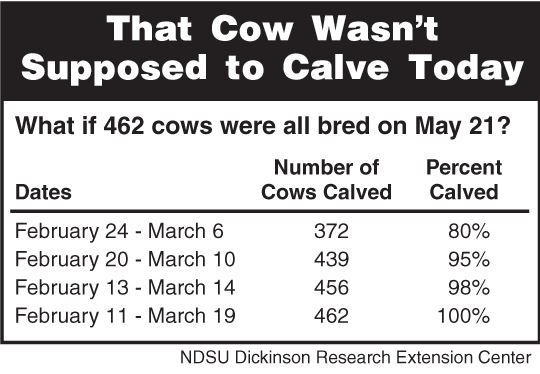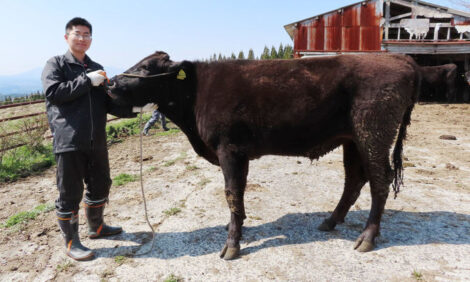



When Should Cows Calve?
Very few cows calve on their due date, but how can a ranch know what to expect?Studies have yielded calving windows of a month for herds all conceiving on the same day.
Basically, a cow will calve when she decides the time is right, according to Kris Ringwall, beef specialist at North Dakota State University extension.
"All of us have seen the old cow that gets up, lays down, gets up, lays down, walks over to the corner, walks back, lays down, twitches her tail and calves two weeks later," writes Mr Ringwall in a recent BeefTalk newsletter.
"We’ve also seen the cow with no udder, but calves in what seems to be just minutes and successfully produces a normal calf that is well-fed after a day."
Including Cows in the Calving Distribution
BeefTalk reader Nick noted: “I wanted to make sure I thoroughly understood the last article concerning the 60 per cent of the cow herd calving in the first 21 days. Did the 21 days start when the first calf hit the ground dead or alive or with the first healthy calf or does the 21 days start when you put the bulls out?”
Good question. In terms of our data, the CHAPS benchmarks start counting when the third mature cow calves in the herd or 283 days after the bull turnout date. The bull turnout calculation will be used unless the third mature cow starts to calve more than 10 days before the projected calving date. In that case, the date the third mature cow calves is used.
From a practical side, the bull turnout date plus 283 days is simple. If there are cows that calve early and have small or weak calves, I would not recommend using those calving dates. As a producer, one experiences those early births that one knows are not representative of a full-term pregnancy. Those births should not be included in calculating the starting date for the first 21 days of calving.
After pondering the question some more, I thought of a previous data set that another producer, Connie, had asked about. The focus of the data set question was on how predictable the calving date is.
At the time, many groups of cows were being sold with projected calving dates, so the data is worth repeating. Most, if not all, producers have a handy calving gestation table. These tables will differ slightly depending on breed.
The tables will project the calving date using the day the cow was bred. For example, a cow bred on May 21 may be projected to calve on March 1. Do the cows start on March 1? Unfortunately, the cow does not read the tables.
Trying to Guess
Granted, the aging of a developing fetus is very accurate, writes Mr Ringwall. But, gestational age and calving date have very little in common and have different traits.
Attempting to guess what day a cow is going to calf is difficult. Here is why: In reviewing Dickinson Research Extension Center cow records through several breeding seasons, 462 cows were artificially inseminated and conceived to the unit of semen she was inseminated with.
Due to the different breeds used, the parentage of the calf was not questionable. Of these 462 cows, the average gestation length was 282.5 days. Of the 462 cows, only 87 calved on the expected date. These cows were expected to calf 283 days after breeding, which was March 1.
In reality, the first live calf arrived Feb. 11, then one on the 13th and one on the 16th. Three calves arrived on Feb. 17, three on the 19th, one on the 20th, three on the 21st, nine on the 22nd, eight on the 23rd and a rush on the 24th produced 17 calves.
Now the calving season was well under way. On Feb. 25, 19 calves were born, 36 on the 26th, 38 on the 27th and 39 on the 28th. On the March 1 due date, 87 calves were born.
With all the new calves, the calving crew was working up a sweat despite the cold weather. On March 2, 53 cows calved, 25 on the 3rd, 16 on the 4th, 22 on the 5th, 20 on the 6th, 15 on the 7th and four on the 8th.
Just as there appeared to be a let-up, 15 calves were born on March 9, 12 on the 10th and one on the 11th. The season finished with two calves on March 12, three on the 13th, three on the 14th and one calf each on March 15, 16 and 17. The last two calves were born on March 19.
A case in point, the calving season for a group of 462 cows that all conceived on the same day lasted 32 days. Approximately 65 per cent calved within a 10-day window, 95 per cent in a 19- day window and 98 per cent within a 28-day window.



